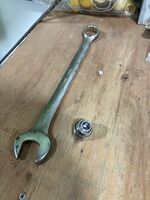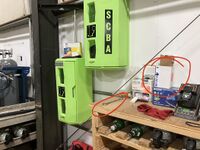Difference between revisions of "Refilling SCBA Bottles"
Zarvanitis (talk | contribs) (Fix hydro test frequency) |
Zarvanitis (talk | contribs) (Added subsection about the RIT adapter, since I feel bad for dragging Chief Mike to the station on a Sunday) |
||
| Line 30: | Line 30: | ||
# Put the bottle into the obvious slot with the connections and gauge upward. | # Put the bottle into the obvious slot with the connections and gauge upward. | ||
# Connect the fill line and ensure it's actually attached. Same connection as when you're replacing the bottle on a pack, so just knock it into place and confirm it's on. | # Connect the fill line and ensure it's actually attached. Same connection as when you're replacing the bottle on a pack, so just knock it into place and confirm it's on. | ||
#* | #*For RIT bottles, see notes below on the necessary adapter. | ||
# Ensure the line bleed valve is closed! Otherwise you'll be pumping air out into the hall instead of into the bottle. | # Ensure the line bleed valve is closed! Otherwise you'll be pumping air out into the hall instead of into the bottle. | ||
# Once the bleed valve is closed, fully open the bottle valve. You'll hear a gentle hiss as the pressure in the fill line increases to equalize with the tank. | # Once the bleed valve is closed, fully open the bottle valve. You'll hear a gentle hiss as the pressure in the fill line increases to equalize with the tank. | ||
# Close the filling compartment and jiggle to ensure it's locked shut. | # Close the filling compartment and jiggle to ensure it's locked shut. | ||
===== Connecting a RIT bottle ===== | |||
[[File:RIT fill adapter.jpg|thumb|200x200px|RIT fill adapter]] | |||
Our RIT bottles have a screw-on attachment rather than the quick-disconnect attachment on our pack bottles. You'll need an adapter, which should live near the compressor somewhere. See the image at right for what it looks like. It is often found on the wood bench or in a small box on that bench to the right of the fill station. The fill adapter screws on to the RIT bottle. Give it a ''very'' gentle tighten with a 15/16" wrench, and then use the quick connect attached to the fill station. Remember to disconnect the adapter afterward, or you'll have trouble setting up the RIT pack! | |||
Note that this adapter is different from the inverse adapter we use to fill our pack cylinders from threaded fill stations like those used by Anacortes. ''That'' adapter lives in the SCBA battery pack on 11-12 so that it's available for our use on long calls. | |||
[[File:RIT fill adapter location.jpg|thumb|200x200px|Where to find the RIT adapter]] | |||
===Preparing to fill=== | ===Preparing to fill=== | ||
Latest revision as of 21:59, 5 November 2023
This process should only be used by trained + authorized people – if you're not sure, don't do it! Consequences for getting this wrong can be high.
Our compressor and fill tanks are located in the apparatus bay at Station 1.
In general, we consider bottles in need of refill any time we see them below 4000 psi.
Documentation
It's crucial that we document every bottle we fill. Some of the many reasons:
- If we ever find that the compressor was malfunctioning and putting something undesirable in the air during some period of time (or if air quality was just really bad one day), we need to know which bottles to take out of service until we can refill them with air we actually want to breathe. (We test the air quality periodically to ensure we're filling bottles with breathable air.)
- It forces us to check that the bottle is within its hydro test validity – a hydro test is only good for five years, after which we do not fill the bottle until it can be hydro tested again. This is a safety issue.
To document the bottles you're filling, you'll need:
- the date
- the bottle number (this is the big ol' MEFD number on the side of the bottle, usually three digits)
- the bottle brand – most will be Luxfer, but not all (RIT bottles are different, possibly?)
- manufacture date – printed right near the bottle brand, I believe
- last hydro test date – if I'm remembering right, this will be in small font on an official-looking sticker. MUST be within the last five years.
- department – "MEFD" for our bottles, but list other departments if we're filling up for others as part of a large training or incident.
After you fill, you'll also list the pressure you filled to and your name.
Getting started
- Do a quick inspection of the bottle for dings, flaking fiberglass, or other issues. Don't fill bottles you don't 100% trust.
- Fill in the start of our documentation sheet for the bottle by finding the info listed above.
- Push down on the safety bar and open the filling compartment.
- Put the bottle into the obvious slot with the connections and gauge upward.
- Connect the fill line and ensure it's actually attached. Same connection as when you're replacing the bottle on a pack, so just knock it into place and confirm it's on.
- For RIT bottles, see notes below on the necessary adapter.
- Ensure the line bleed valve is closed! Otherwise you'll be pumping air out into the hall instead of into the bottle.
- Once the bleed valve is closed, fully open the bottle valve. You'll hear a gentle hiss as the pressure in the fill line increases to equalize with the tank.
- Close the filling compartment and jiggle to ensure it's locked shut.
Connecting a RIT bottle
Our RIT bottles have a screw-on attachment rather than the quick-disconnect attachment on our pack bottles. You'll need an adapter, which should live near the compressor somewhere. See the image at right for what it looks like. It is often found on the wood bench or in a small box on that bench to the right of the fill station. The fill adapter screws on to the RIT bottle. Give it a very gentle tighten with a 15/16" wrench, and then use the quick connect attached to the fill station. Remember to disconnect the adapter afterward, or you'll have trouble setting up the RIT pack!
Note that this adapter is different from the inverse adapter we use to fill our pack cylinders from threaded fill stations like those used by Anacortes. That adapter lives in the SCBA battery pack on 11-12 so that it's available for our use on long calls.
Preparing to fill
- Ensure all the storage tanks' connections to the fill station are open.
- Set the fill station to fill from storage (or from compressor if the highest-pressure storage bank is filled to less than 4500 psi).
- Open the lowest-pressure storage bank (conventionally, we use Bank #1 first, then #2, and so on) to give yourself some inlet pressure. To do so, turn the knob under the desired bank all the way to the left, then back off a quarter turn. You should see the inlet pressure gauge at bottom left equalize with the open bank.
- Set the desired fill pressure (4500 psi unless otherwise noted) by adjusting the regulator knob (between inlet + fill pressure gauges). Note that if the set fill pressure is lower than the inlet pressure, there will be a loud hiss as the fill station bleeds off excess air.
Fill
In general, we'll fill from the storage tanks until we need to top them off with the compressor. The compressor should be set to turn on when any of the banks drop below a certain pressure.
From storage tanks
- You should already have one storage tank valve open.
- Open the fill valve for the bottle(s) you want to fill. Do so slowly! Filling too fast results in really warm bottles, which will require additional top-off later once they've cooled and the pressure has dropped. Some departments also say that filling too fast can lead to bottle failure, so let's definitely avoid that. Ideal fill rates seem to be 200-400 psi per minute.
- If the lowest-pressure storage tank equalizes with the bottles you're filling below 4500 psi, you'll need to shift to the next storage tank. To do so:
- Turn off the fill valve for your bottle(s). This will allow you to adjust the fill rate once the higher-pressure storage tank is opened – otherwise you might hot fill your bottles without meaning to.
- Turn off the storage tank you're currently filling from.
- Open the next-lowest-pressure storage tank. (As before, open all the way, then back off a quarter turn.)
- Open the fill valve for your bottle(s), again aiming for 200-400 psi per minute.
For an explanation of why we start with the lowest-pressure storage tank, see the video below for a discussion of cascade fill systems. It's really quite clever.
From compressor
NOTE: If the compressor kicks on, you and everyone in earshot will need ear protection.
If the lowest-pressure storage tank still isn't enough to get your bottles up to 4500 psi, it's time to switch over to the compressor.
Wrap up the process
- Turn off the fill knobs (bottom right) to cut off additional air to the bottles you're filling.
- Turn off the bank you're currently filling from.
- Open the filling compartment to reveal your newly-filled bottles.
- Close the main valve on the newly-filled bottles (the one you use to open/close the bottle when it's on your pack).
- Bleed off excess pressure in the fill lines using the bleeder valves. As a courtesy to the next person filling bottles, close the valves when you've finished (just finger tight, no need to torque down too much). Ensure nobody has their face too close to the bleeder valve as there will be very high-pressure air whooshing out.
- Disconnect the bottles. If you've filled fast, be careful as the bottle will be warm.
- Finish documenting the bottles you've filled by entering the pressure you filled 'em to and your name.
Other resources
- To do: find and link manual for the compressor (CFS 5.5)

